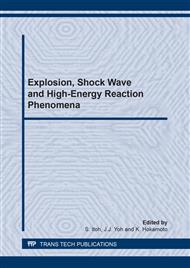p.59
p.65
p.71
p.77
p.83
p.89
p.95
p.101
p.107
Influence of Temperature on Dynamic Behavior of Rubber Materials by Taylor Impact Test
Abstract:
The understanding of the deformation behavior of rubber materials under high strain-rate or high loading-rate conditions will be important in their impact applications adopting significant viscoelastic behavior. Taylor impact test has originally used to determine the average dynamic yield strength of metallic materials at high strain rates, but it also can be used to examine the overall deformation behavior of rubbers representing large elastic deformation by using a high-speed photography technique. Taylor impact tests of rubber materials were carried out in the velocity range between 100~250 m/s using a 20 mm air gun. In order to investigate the overall dynamic deformation behavior of rubber projectiles during Taylor impact test, a 8-Ch high-speed photography system which provides a series of images at each elapsed time was incorporated. Three kinds of rubber materials with different Tg (glass transition temperature) were supplied. The bulging behavior of rubber projectile could be evaluated quantitatively by digitizing images taken. Taylor impact tests at various temperature levels were conducted to predict the bulging behavior of rubbers at high strain rate.
Info:
Periodical:
Pages:
83-88
Citation:
Online since:
January 2011
Authors:
Price:
Сopyright:
© 2011 Trans Tech Publications Ltd. All Rights Reserved
Share:
Citation:


